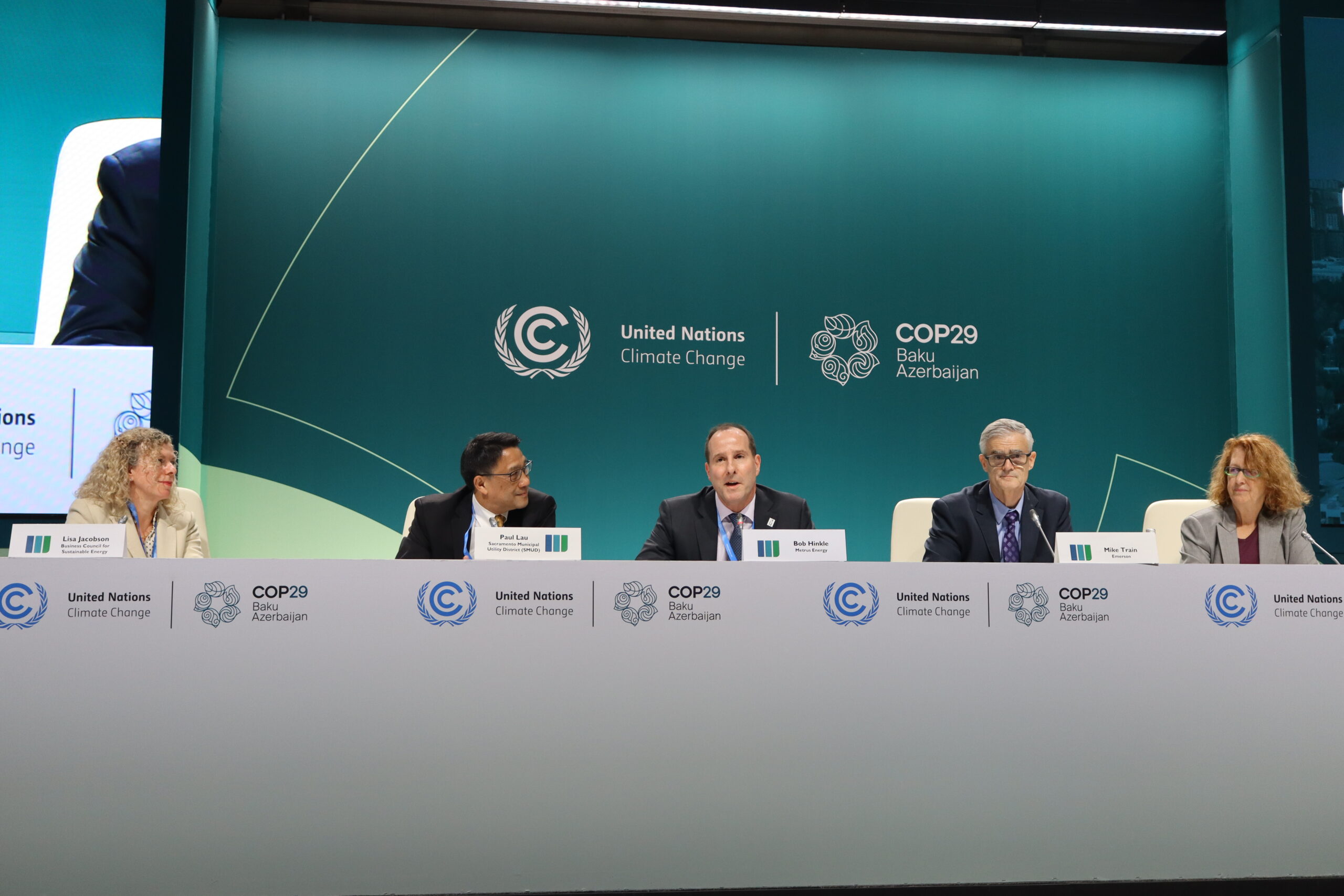By Laura Tierney, Vice President, International Programs, BCSE
Last month, BCSE led a delegation of nearly 30 U.S. businesses and clean energy trade organizations to the 29th Conference of the Parties (COP 29) to the United Nations Framework Convention on Climate Change (UNFCCC) held in Baku, Azerbaijan, from November 11 – 24. As BCSE’s delegation shared private sector solutions to address the global challenge of climate change mitigation and adaptation, country negotiators worked to find compromise on difficult financial questions.
COP 29 concluded with the delivery of a new collective goal for international climate finance and the final rulebook for UN-backed international carbon markets. The negotiating parties did not advance implementation of the energy transition goals of last year’s Global Stocktake (GST).
Here are BCSE’s top three takeaways on the COP 29 outcome:
1) The COP 29 agreement on increased public climate finance recognizes a clear need for private sector investment and creates space for even greater public-private action.
Upon the COP’s conclusion, countries agreed to mobilize $300 billion of international public climate finance by 2035 – and to identify a pathway toward identifying sources to deliver up to $1.3 trillion.
This new goal can be reached by mobilizing all finance sources and utilizing different types of funding tools, such as carbon markets, to accelerate the clean energy transition in more countries and communities. In addition to public finance, governments will need to deploy a mix of policy tools to leverage the true power of private sector investment.
Business must also be involved early and often in discussions that shape the policy, market, and legal environments that will enable and accelerate private sector investment in the energy transition. Partnership with the private sector can help accelerate progress of the clean energy transition where it is most needed in developing countries.
Carbon markets will help deliver essential finance flows to developing countries as they build their own sustainable and decarbonized economies. The ability to utilize carbon markets will also help corporations advance toward their own climate targets and decarbonize their operations and supply chains. With the rulebook now finalized, countries and companies can move forward to deploy emissions reduction solutions and make market improvements as needed.
2) Public-private partnerships across industries and borders are crucial to doubling energy efficiency improvement and tripling renewable energy capacity by 2030.
At COP 29, BCSE welcomed the addition of two new global goals to accelerate the energy transition, to increase energy storage deployment to 1500 GW and double grid investment (deployment of 25 million kilometers of grid infrastructure) by 2030. These serve to facilitate and expand upon the COP 28 agreement to double the rate of energy efficiency improvements and triple renewable energy capacity by 2030.
In Baku, BCSE championed the need for cross-sectoral and cross-border partnerships to advance these energy transition goals. The energy efficiency and clean energy solutions needed to reach these targets are commercially available today, and partnership opportunities abound to get projects off the ground even faster.
Over the course of 2025, BCSE will call upon countries to embrace these energy transition goals and incorporate these milestones into their updated national climate plans due in February 2025. BCSE will offer member expertise and industry knowledge in helping shape pathways to achieve these goals.
3) The foundation of the clean energy transition is hard-wired into the global economy. Nevertheless, greater ambition and inclusion of transition goals in the next round of national climate plans is critical to maintain and increase momentum.
We must all continue to raise ambition for tackling climate change. Climate impacts are already hitting nearly every country and creating enormous economic, environmental, and social disruptions at levels never seen before.
The costs of inaction are clear. Even more clear is the momentum behind the clean energy transition. Governments must enable, not impede, the energy transition.
COP 29 revealed that the inter-governmental process of the UN-led climate change negotiations reflects and includes a diverse array of views when it comes to the energy transition and the pace of climate action. While BCSE knows the progress of the clean energy transition to be unstoppable, we also know that its progress is uneven across the globe, and the level of resources – including natural, political, and fiscal – to accelerate progress are varied.
The value of the UN-led process on climate change is that it creates an essential opportunity for national governments to create and send important signals to all stakeholders of where climate action is heading. The private sector and subnational governments then respond, and some send back their own raised levels of ambition. This positive feedback loop creates additional market signals for investment and can open new economic development opportunities that will broaden the reach of the benefits of the clean energy transition – including clean, affordable, and reliable energy access for all, but also health, resilience, and job creation benefits.
For more information on the BCSE’s engagement at COP 29, please visit our COP 29 webpage and read BCSE’s Commitment to the Energy Transition and Climate Action: Increasing Ambition at COP 29. Plus, read BCSE’s statement on the COP 29 outcomes.
About the Author: Laura Tierney is the Business Council for Sustainable Energy’s vice president of international programs.

